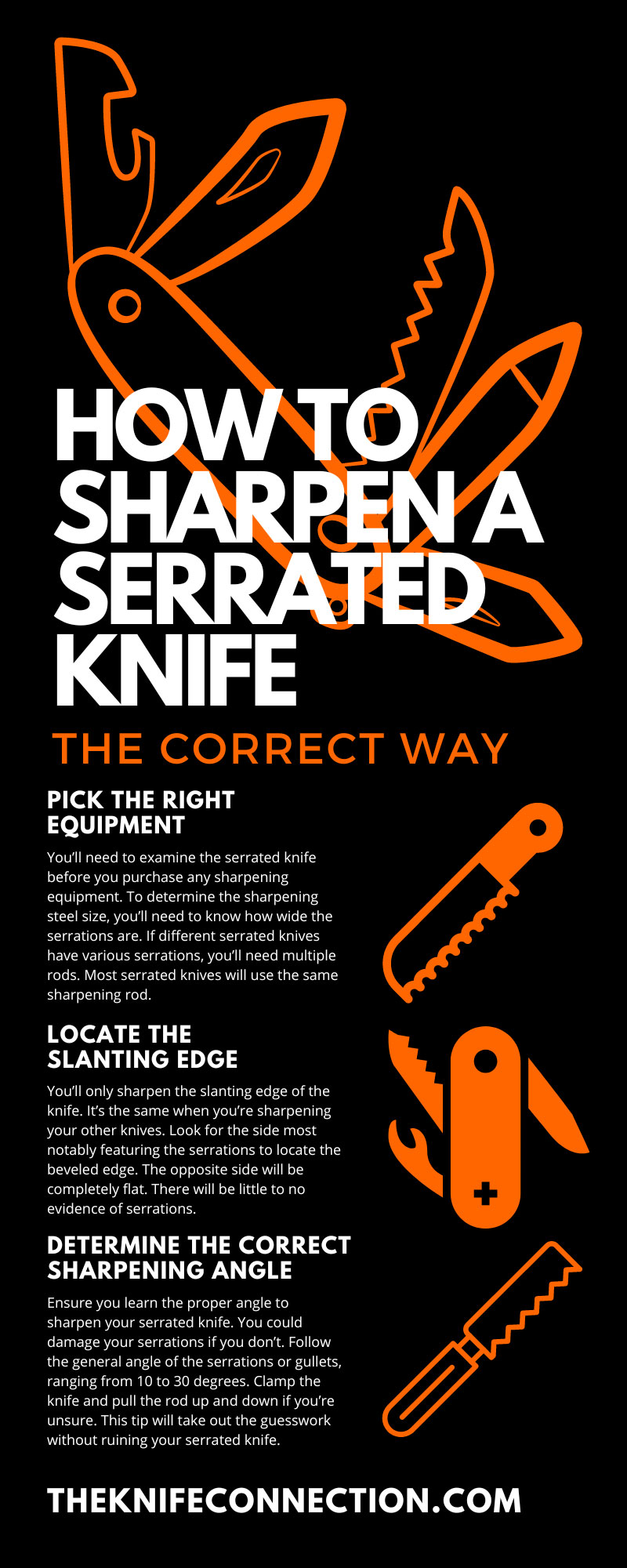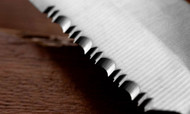How To Sharpen a Serrated Knife the Correct Way
Jul 12 2023 - 8:23
Sharpening your knife is part of regular knife maintenance. It helps ensure your blade is in tip-top shape and will continue working effectively and efficiently. Serrated knives are an intimidating type of knife to sharpen. It’s not straightforward sharpening like with a chef’s knife. Continue reading to explore how to sharpen a serrated knife the correct way.
The Importance of Serrated Knives
Serrated knives resemble saws. The sharp points and rounded tips create an incredibly efficient kitchen knife. Although the kitchen isn’t the only place you can use a serrated knife, it’s the most popular spot to find them.
You may also know serrated knives as bread knives. It can slice through food with resistant or thick surfaces with ease. Think of crusty bread or the skin of a tomato. This knife excels at making cuts where you drag the edge across the food.
There’s no better example of a serrated knife showing off its specialty than with a loaf of bread. You must cut through the hard crust without smooshing the soft inner layers. If you attempted to slice bread with a chef’s knife, you would compress it. A serrated knife, however, will catch and cut the food by moving across the loaf. That’s the beauty of the uneven edges.
Serrated knives are relatively low-maintenance, and the design has superior edge retention. Unlike other kitchen knives, you’ll only need to sharpen them once every few years. In fact, you could go several years between sharpenings. Your serrated knife could be dull and still work efficiently. This perk is because of the serration’s chisel grind, which has less contact with food.
Sharpening Serrated Knives: Step by Step
Create a clean, clear workspace before beginning the sharpening process. Lay the knives on a clean kitchen towel or a cutting board for easy access. For safety reasons, you can use pliers or a clamp to hold the knife during the sharpening process. This tip will provide stability and keep you from getting cut. It will also make the process easier.
Ensure you have a first aid kit nearby and handy just in case. Ask a family member or friend to help if it makes you feel more comfortable. They can hold the blade steady while you sharpen it and be there to help if anything goes wrong.
Pick the Right Equipment
You’ll need to examine the serrated knife before you purchase any sharpening equipment. To determine the sharpening steel size, you’ll need to know how wide the serrations are. If different serrated knives have various serrations, you’ll need multiple rods. Most serrated knives will use the same sharpening rod.
Flat files and edge sharpeners won’t work for serrated knives. A V-shaped knife sharpener may be worth the investment. It will work for various knife types, which means one sharpener for different knives. It’s more money up-front but will save you in the long run.
Locate the Slanting Edge
You’ll only sharpen the slanting edge of the knife. It’s the same when you’re sharpening your other knives. Look for the side most notably featuring the serrations to locate the beveled edge. The opposite side will be completely flat. There will be little to no evidence of serrations.
Avoid sharpening the wrong side because you’ll damage the serrated knife. You can start the process once you’ve determined the correct side.
Determine the Correct Sharpening Angle
You could have difficulty positioning the sharpening iron and knife during the process. That’s why using vice-grips, such as pliers, will help. You won’t need them if you’re using a V-sharpener. Some people like to clamp the sharpening rod down and pull the knife across. It’s all about preference. Feel free to try a few different ways until you find what works.
Ensure you learn the proper angle to sharpen your serrated knife. You could damage your serrations if you don’t. Follow the general angle of the serrations or gullets, ranging from 10 to 30 degrees. Clamp the knife and pull the rod up and down if you’re unsure. This tip will take out the guesswork without ruining your serrated knife.
Change Tools As Needed
Serrated knives have various serration edges, sizes, and types. These things can all be within the same blade. You’ll need to change the diameter of your sharpening rod when working with different serrations.
Don’t hesitate to reach out to a knife-sharpening expert if you’re unsure. You can even hire them to sharpen your knives, or they can guide you through the process.
File Burrs and Test the Knife
You’ll notice small metal wisps as you’re sharpening your knife. They’ll appear on the back of the blade. These wisps are similar to the sawdust that appears when you’re cutting wood. You’re shaving away metal, and the little pieces are the proof. Periodically feeling for burrs will help you gauge how much metal you’re removing. If you feel a lot, you could potentially weaken your serrated knife. File away the burrs after sharpening the knife. This filing will remove them and create a smooth surface.
Testing out your knife is the last step for sharpening. Have a vegetable close by to test out the blade. You can continue sharpening the knife if you’re unsatisfied with the results. Clean off the knife blade and sharpen it slowly until it’s to your standards.
Knife No-Nos
It may take some time and practice before you feel confident in your knife-sharpening skills. Of course, you don’t want to make mistakes while learning. It could lead to a ruined knife. Explore these common mistakes made by beginners.
One of these mistakes is not securing the knife before sharpening it. Trying to hold the knife and sharpening rod can still be incredibly tricky. Securing your knife with a vice grip could be the difference between a well-sharpened knife and a ruined one.
Never, ever, ever put your serrated knife in the dishwasher. It will damage your knife by weakening the serrations, creating a dull blade. Hand-washing your knives is the only way to go.
Unfortunately, many people make the mistake of removing too much metal. You can always shave more off, but never add the metal back. Take your time during the sharpening process to ensure you’re not damaging your knife.
Now you can extend the lifespan of your serrated knife by sharpening it correctly. Ensure you’re purchasing quality knives to begin with. The Knife Connection offers many incredible, high-quality brands. One of them is TOPS. Browse our TOPS knives for sale to find the right one for you. Don’t forget the knife accessories, as well.

